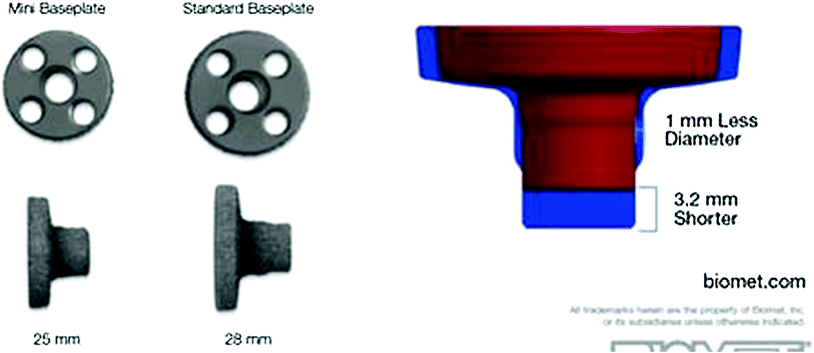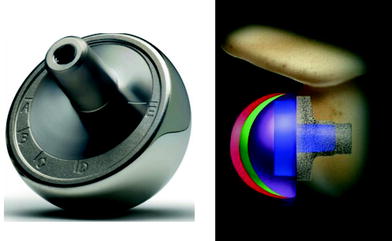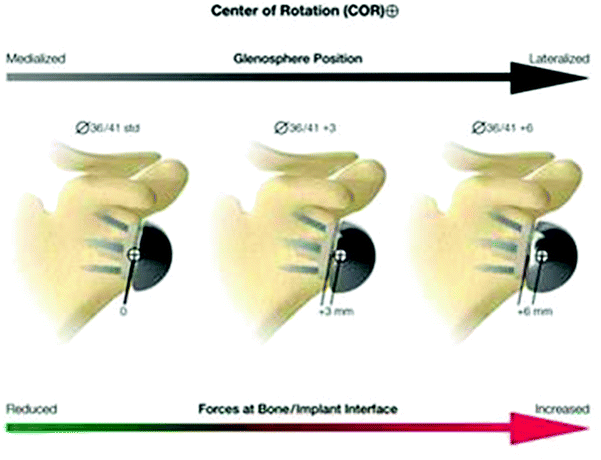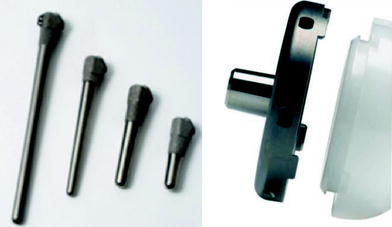Fig. 32.1
Biomet Comprehensive® reverse shoulder arthroplasty (RSA)

Fig. 32.2
Biomet Comprehensive® reverse shoulder arthroplasty (RSA) is the result of the combination of the Biomet Comprehensive® shoulder system, based upon a humeral stem component platform, with the different specific parts of the reverse “ball-and-socket” design: the humeral tray and bearing, the glenospshere, connected to the baseplate by the morse taper
The Glenoid Side
The glenoid component consists of a number of different glenospheres, which articulates by way of Morse taper with one of 2 sized baseplates.
The Glenoid Baseplate (Fig. 32.3)
The baseplate comes in 2 diameters (28 and 25 mm) in order to accommodate patients with small glenoid vaults or pathologic bone loss. The component is low profile with hydroxyapatite over PPS® Porous Plasma Spray to improve osseous integration. The design includes a short central boss housing to accommodate a modular 6.5-mm screw for rigid compression into the glenoid vault in 5-mm increments from 20 to 50 mm. The baseplate has 4 peripheral screw holes, which can accommodate 4.75-mm locking or non-locking screws in lengths from 15 to 45 mm and up to 6° of angulation in any direction (locking only). The glenosphere component to be described later articulates by way of a variable Morse taper design.


Fig. 32.3
The low-profile HA-PPS®-coated baseplate with its central boss housing and its 4 peripheral locking screw holes: comparison of the standard 28 mm diameter with the mini 25 mm diameter
The low-profile hydroxyapatite and PPS®-coated baseplate can be implanted flush to the reamed glenoid surface. The central compression screw and boss housing enhance bony ingrowth and resist micro-motions, which could retard this integration [1]. The central boss of the baseplate was created to increase resistance to any shear loading, and the 6.5-mm central screw design was chosen to improve this compression effect [2]. The use of 4 peripheral screws has proven in previous designs to minimize micro-motions especially in designs with a central peg configuration [3]. While the use of 5-mm-diameter locking screws in a fixed angle of inclination has been reported to improve fixation in other designs, the Comprehensive® RSA provides 4 screw holes for 4.75-mm-diameter locking or non-locking screws with variable degrees of inclination [4]. This in conjunction with the central compression screw and central boss housing is supposed to offer the best chance for osseous integration.
As stated above, this system utilizes HA-PPS® coating which has proven to be very effective in obtaining biologic osseous integration for several years in hip replacement systems utilizing this technology [5].
The Glenosphere (Fig. 32.4)
The Biomet Comprehensive® Reverse System utilizes multiple cobalt–chrome hemispheric glenospheres. The glenosphere component is available in 36 and 41 mm diameters and comes in 3 sizes of lateral offset for each, including 0, +3, and +6 mm. The glenosphere articulates by way of the Versa-Dial® technology, which incorporates a revolutionary variable Morse taper within a taper system allowing for infinite offset combinations in all directions between 0.5 and 4.5 mm in 41-mm glenosphere, and 0.5 and 3.5 mm in standard 36-mm glenosphere. This variability gives the possibility for the surgeon to dial the chosen degree of offset inferiorly, antero-inferiorly, or postero-inferiorly to create the best stability, range of motion (ROM), and avoid notching. It also allows for the use of a smaller baseplate in better bone stock and placement of the glenosphere in optimal position as well.


Fig. 32.4
The Biomet Versa-Dial® glenosphere (on left), with its Morse taper system allowing infinite offset combinations between 0.5 and 4.5 mm in all directions, and within 3 sizes of lateral offset for each including 0, +3, and +6 mm (represented on right)
This glenosphere design allows for lateralization without compromising the glenoid baseplate fixation because of excessive shear loading [6] (Fig. 32.5). Use of a +3 or +6 mm offsets may allow the surgeon to place the glenosphere in a more advantageous position in cases of medial glenoid erosion or wear without the need for BIO-RSA-type grafting. Lateralization or use of a larger 41-mm glenosphere may be the best option for improving external rotation by retensioning the remaining remnants of the posterior rotator cuff especially if the teres minor is present.


Fig. 32.5
Correlation between the position of the center of rotation and the shear forces at the bone implant interface
The Versa-Dial® technology also allows inferior offset of the glenosphere between 0.5 and 4.5 mm, which can effectively prevent inferior impingement and scapular notching [7–9]. Theoretically, more posterior offset might enhance active external rotation.
Another reported solution to scapular notching, however controversial [10], is inferior tilt [11] of the glenosphere. While some eccentric glenosphere designs may create this tilt, instrumentation available in this system allows the surgeon to ream the glenoid in up to 10° of inferior tilt. In combination with the Versa-Dial® system, it looks to be an acceptable compromise for preventing inferior notching.
As described above, the multiple offset options available with the Versa-Dial® technology can be helpful for managing different anatomical abnormalities such as bone loss or glenoid deformities. Often in these glenoid bone deformities, standard baseplate positioning may not be possible. In these cases, the baseplate can be placed in the best possible bone and then utilizing the Versa-Dial® technology and/or a lateral offset glenosphere, and the surgeon can place the implant in the most biomechanically advantageous position. Thus, the Versa-Dial® modularity can be used as a salvage method for technically demanding cases, allowing a good balance between solid fixation and avoidance of complications.
Finally, the Biomet Comprehensive® glenosphere with the Versa-Dial® system offers the opportunity to the surgeon to combine consistently every important recognized positioning parameter in one component.
The Humeral Side (Fig. 32.6)
The Biomet Comprehensive® RSA humeral component consists of a humeral stem component, which articulates with an on-lay humeral tray and liner by way of a reverse Morse taper.


Fig. 32.6
The Biomet Comprehensive® RSA humeral component: large wide range of platform proximal coated stem (mini, standard, fracture, or revision), articulated by a reverse morse taper with an on-lay humeral tray thickened up to 10 mm, and assembled to a retentive or not humeral bearing
The Humeral Stem
The Biomet Comprehensive® shoulder stem has been designed as a universal component platform affording the ability to interchange the metaphyseal and epiphyseal components, whatever the type, the length, and the mode of fixation of the stem as dictated by the pathologic anatomy. For this reason, there is no need to remove a well-fixed humeral stem component whether a conversion from an anatomic to a reverse configuration or the opposite is necessary. In this system, any type of humeral stem component including standard stems of all lengths, fracture stems, and even modular humeral replacement stems can be utilized in this reverse system. Thus, this humeral stem is not a specific component for the RSA.
The Biomet Comprehensive® shoulder stem is available in different length and design: micro (55 mm), mini (83 mm), standard (122 mm), revision, and fracture (194 mm). The micro, mini, and standard are all available in 1-mm increments from 4 to 20 mm (revision and fracture by 2 mm up to 14 mm). The neck-shaft angle of the stem is 45°/135°. It can be used cemented or un-cemented with a PPS® Porous Plasma Spray coating.
The length and the type of the fixation of the humeral stem continue to provoke some controversy. Given the fact that the reverse prosthesis is a semi-constrained implant, there is concern by who feel that greater constraint forces are redistributed and directed to the humeral component. In some revision cases with significant humeral bone loss, a cemented long stem may be preferable. We now advocate the use of a short uncemented mini-stem, which avoids stress shielding, humeral component subsidence, and loosening [12]. Use of this implant may decrease the rate of preoperative and postoperative humeral shaft fractures and facilitate the revision if needed [13]. In case of fracture for elderly people, the use of a hybrid humeral component, coated neck with sutures holes and cemented stem, remains the primary option [14].
Consequently due to the wide range of adaptable Biomet Comprehensive® shoulder stems (length, size, type of fixation), reconstruction on humeral side during a reverse shoulder prosthesis procedure becomes more accurate, specific, and well adapted to the surgical treatment indication of each patient.
The Humeral Tray
As opposed to the Grammont’s design, the modular humeral tray allows to the universal Biomet Comprehensive® shoulder stem to be converted into an on-lay Biomet Comprehensive® RSA.
The 44-mm humeral tray can be standard or thickened of 5 or 10 mm. It provides an efficient locking RingLoc® mechanism for easy and reliable fixation of the different types of humeral bearings. It also provides 6 suture slots at its periphery for additional attachment points in case of tuberosities reconstruction for fractures or revisions.
The 44 mm fixed diameter of the humeral tray is well adapted to the most dimensions of the humeral neck surface. It allows for avoiding prosthetic overhanging and its adverse effects on the peripheral soft tissues. The availability of the standard, +5 and +10 mm, thickened trays with various thicknesses of polyethylene liners including retentive types results in up to 18 mm of available buildup that is very helpful for managing bone loss in case of revision or fracture cases, or for compensating a non-accurate humeral cervico-cephalic cut. It allows for better soft tissue tensioning and consequently may help prevent prosthetic instability [15].
The Humeral Bearing
The humeral ArComXL® bearing includes 12° angle, making the neck-shaft angle 33°/147°, after having been assembled with the Biomet Comprehensive® shoulder stem whose neck-shaft angle is 45°/135°. It is available in standard and in +3 mm thickened without and with retentive option. It provides an anti-rotation tabs system for avoiding unclipping complication.
The choice of a 147° neck-shaft angle looks to be the best biomechanical compromise. On one side, if the angle is greater than 145°, there is less impingement and a better deltoid moment arm, but the prosthetic stability is decreased. On the other side, if the angle is lesser than 145°, it implies a lateralization of the joint center of rotation with the positive effect of increasing stability and a better efficiency of the external rotator cuff muscles, but it also exposes to more impingement and notching occurrence [15, 16].
Stay updated, free articles. Join our Telegram channel

Full access? Get Clinical Tree








